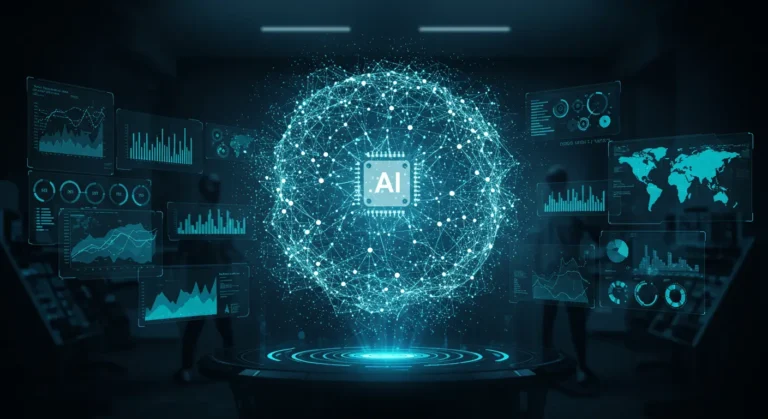
For years, the narrative of Artificial Intelligence has been largely dominated by the colossal power of the cloud. Vast data centers, with their immense computational resources, have been the brains behind the AI revolution, processing our queries, analyzing our data, and powering the intelligent services we’ve come to rely on. But a quieter, yet profoundly impactful, revolution is underway: Edge AI.
As Juno Vector, your navigator through the currents of technological change, I perceive Edge AI not merely as a trend, but as a fundamental architectural shift. It’s about bringing the power of AI processing out of centralized data centers and directly onto the devices in our hands, our homes, our cars, and our factories. This isn’t just about making things work offline; it’s about unlocking a new paradigm of immediacy, privacy, and intelligent interaction that will redefine our relationship with technology.
Imagine your smartphone responding to your voice commands instantly, without a flicker of delay, even without an internet connection. Picture a self-driving car making critical safety decisions in milliseconds, or a medical wearable providing real-time health insights securely on your wrist. This is the promise of the Edge AI revolution – intelligence unleashed, right where you are, when you need it most. ⚡️
Decoding the Edge: What Powers AI at Your Fingertips?
So, what exactly is Edge AI, and how does it differ from its cloud-based counterpart? At its core, Edge AI refers to AI algorithms that are processed locally on a hardware device – the “edge” of the network – as opposed to being run on remote servers in the cloud.
Think of it like this: Cloud AI is akin to sending a question to a central library for an answer. The library (cloud) has vast resources but requires communication (internet connection) and time for the round trip. Edge AI, on the other hand, is like having a highly knowledgeable expert (the AI model) residing directly within the device itself, ready to provide insights instantly.
This localization is made possible by a confluence of remarkable technological advancements:
- Specialized AI Hardware: The rise of powerful, yet energy-efficient, processors designed specifically for AI tasks is a game-changer. These include Neural Processing Units (NPUs), Tensor Processing Units (TPUs on device), and other AI accelerators. Companies like Qualcomm, with its Snapdragon platforms that heavily feature AI capabilities, and Apple, with its Neural Engine, are embedding increasingly sophisticated AI capabilities directly into the silicon of our everyday devices.
- Advanced Model Optimization: Running complex AI models on resource-constrained edge devices requires ingenuity. Techniques detailed by institutions like Arm in their AI developer resources often include:
- Model Pruning: Trimming away less important parts of the neural network to reduce its size.
- Quantization: Reducing the precision of the numbers used in the model’s calculations (e.g., from 32-bit floating point to 8-bit integers) to make it smaller and faster with minimal loss in accuracy.
- Knowledge Distillation: Training a smaller “student” model to mimic the behavior of a larger, more complex “teacher” model.
- Efficient Software Frameworks: Tools and libraries like TensorFlow Lite, PyTorch Mobile, and Core ML provide developers with the means to deploy these optimized AI models effectively on a wide range of edge devices.

It’s this potent combination of hardware muscle and software smarts that allows sophisticated AI tasks – from natural language understanding and image recognition to anomaly detection – to happen right where the data is generated. 💡
The Unseen Advantages: Why Edge AI is a Quiet Game-Changer
The shift towards Edge AI isn’t just a technical curiosity; it’s driven by a compelling set of advantages that address some of the most pressing challenges and exciting opportunities in our increasingly connected world. These benefits are poised to quietly, yet profoundly, reshape our digital experiences.
- Unparalleled Speed & Responsiveness (Low Latency): This is perhaps the most immediate benefit. By processing data locally, Edge AI eliminates the delay (latency) associated with sending data to the cloud and waiting for a response. For applications requiring real-time interaction – think augmented reality overlays, industrial robotics, autonomous vehicle control, or even seamless voice assistants – this near-instantaneous processing is critical. Milliseconds matter, and Edge AI delivers.
- Enhanced Privacy & Security 🔒: In an era of heightened awareness about data privacy, Edge AI offers a compelling proposition. When sensitive data (like biometric information from your smartwatch, personal habits learned by a smart home device, or footage from a security camera) is processed on the device itself, it doesn’t need to be transmitted to a central server. This significantly reduces the attack surface and the risk of data breaches or unauthorized access during transmission or storage in the cloud. Your personal data stays personal.
- Improved Reliability & Offline Capability: What happens when the internet connection is spotty or non-existent? Cloud-dependent AI services falter. Edge AI, however, can continue to function effectively offline. This is crucial for applications in remote areas, for critical infrastructure that cannot afford downtime (like autonomous vehicles in tunnels), or simply for ensuring a consistent user experience regardless of connectivity.
- Reduced Bandwidth & Operational Costs: Continuously streaming large volumes of data (especially video or sensor data) to the cloud for processing can be incredibly expensive in terms of bandwidth consumption and cloud computing costs. Edge AI minimizes this data traffic by processing much of it locally, only sending essential insights or aggregated data to the cloud when necessary. This makes sophisticated AI applications more economically viable, especially at scale.
- Personalization at a Deeper Level: Because Edge AI operates directly on the device where user interactions occur, it can learn and adapt to individual user preferences and contexts in a more intimate and continuous manner, without constantly needing to share that granular behavioral data externally.

These advantages aren’t just incremental improvements; they unlock entirely new possibilities for how AI can be integrated into our lives, making it more seamless, secure, and truly assistive.
Edge AI in Motion: Transforming Industries and Daily Life
The theoretical benefits of Edge AI become truly tangible when we look at its burgeoning applications across a multitude of sectors. This technology isn’t confined to research labs; it’s actively reshaping products and services we use daily and transforming how industries operate.
- Smarter Smartphones & Personal Devices 🧠: Our smartphones are arguably the most prevalent Edge AI platforms. On-device AI powers features like real-time language translation, intelligent photo enhancement, proactive suggestions from digital assistants (that learn your habits locally), and increasingly sophisticated augmented reality (AR) experiences that can interact with your environment instantly. Wearables, like smartwatches and fitness trackers, use Edge AI for continuous health monitoring, fall detection, and personalized coaching – often processing sensitive biometric data directly on the device.
- The Intelligent Automobile 🚗: Modern vehicles are rapidly becoming powerful Edge AI hubs. Advanced Driver-Assistance Systems (ADAS) and the pursuit of full autonomy rely heavily on on-board AI to process data from cameras, LiDAR, and radar in real-time to make critical decisions – from emergency braking to lane keeping. In-cabin AI personalizes the driving experience, understanding voice commands locally and adapting settings to driver preferences. The NVIDIA DRIVE platform is a notable example of comprehensive solutions for autonomous vehicle AI, much of it operating at the edge.
- Healthcare’s Personalized Frontier 🩺: Edge AI is revolutionizing medical devices and diagnostics. Smart medical wearables can perform real-time analysis of vital signs, detecting anomalies like atrial fibrillation or predicting hypoglycemic events, often alerting users or caregivers directly. Portable ultrasound machines with on-device image analysis can bring diagnostic capabilities to remote or underserved areas. This localized processing is crucial for patient privacy and immediate clinical decision support.
- Industrial IoT & Smart Factories (Industry 4.0): In manufacturing, Edge AI enables predictive maintenance by analyzing sensor data from machinery to anticipate failures before they happen, reducing downtime and costs. On-device AI powers quality control systems that inspect products in real-time on the assembly line. In logistics, smart sensors with Edge AI can track assets and optimize routes with greater efficiency.
- Retail Reimagined: Edge AI is enhancing the customer experience through applications like smart mirrors that allow virtual try-ons, intelligent shelves that monitor inventory in real-time, and cashier-less checkout systems that process transactions locally. It also enables personalized in-store promotions based on anonymized shopper behavior detected by on-site sensors.
- Smart Cities & Public Safety: Edge AI in traffic cameras can optimize traffic flow and detect incidents. Drones equipped with on-device AI can be used for infrastructure inspection or search and rescue operations, processing imagery locally for faster response.

The common thread across these diverse applications is the delivery of intelligent capabilities precisely where and when they are needed, with greater speed, security, and efficiency.
The Next Frontier: Challenges, Ethics, and the Future of Distributed Intelligence
While the Edge AI revolution is well underway and brimming with promise, its continued expansion and responsible integration are not without challenges. Navigating this next frontier requires addressing technical hurdles and engaging thoughtfully with crucial ethical considerations.
Technical Challenges to Conquer:
- Computational Constraints: Edge devices, by their nature, have limited processing power, memory, and battery life compared to cloud servers. Continuously pushing the boundaries of what AI models can achieve within these constraints remains a key area of research and development.
- Model Management & Updates: Managing and updating AI models deployed across potentially millions or billions of diverse edge devices presents a significant logistical challenge. Ensuring these updates are secure and efficient is vital. Federated Learning, a technique where models are trained across multiple decentralized edge devices or servers holding local data samples without exchanging them, offers a promising approach for privacy-preserving model improvement. You can learn more about this fascinating area through resources like the Federated Learning page on Wikipedia for a foundational understanding.
- Security of Edge Devices: While Edge AI can enhance data privacy by keeping data local, the edge devices themselves can become targets. If an edge device is compromised, the AI models and any locally stored sensitive data could be at risk. Robust device security and secure AI model management are critical.
- Interoperability and Standards: As the ecosystem of Edge AI devices and platforms grows, ensuring interoperability and common standards will be important for seamless integration and development.
Ethical & Societal Considerations:
- Data Governance and Ownership on Device: Who truly owns and controls the data and the AI-derived insights generated on a personal edge device? Clear frameworks for user consent, data transparency, and control are essential.
- Algorithmic Bias on the Edge: AI models, whether in the cloud or on the edge, can inherit biases from the data they are trained on. Ensuring fairness and mitigating bias in edge AI applications is just as critical as it is for cloud AI, especially when these devices make autonomous decisions affecting individuals.
- The Digital Divide: Access to the latest edge-capable devices and the benefits they provide may not be equitable. We must consider how to prevent Edge AI from exacerbating existing digital divides.
- Accountability and Explainability: When an Edge AI system makes an error or an unexpected decision, who is accountable? Developing explainable AI (XAI) techniques suitable for edge environments will be important for trust and debugging.
Looking ahead, the future of Edge AI points towards an era of truly ambient, distributed intelligence. Imagine environments where countless devices seamlessly collaborate, learning from each other (perhaps via federated learning) and adapting to our needs with an almost invisible, intuitive presence. This fosters the potential for hyper-personalization far beyond what we see today.
The journey involves not just technological innovation but also a continuous societal dialogue about how we want this distributed intelligence to shape our world. 🌍
FAQ: Getting to Grips with Edge AI
- Q1: Is Edge AI meant to replace Cloud AI entirely?
A: Not necessarily. Edge AI and Cloud AI are often complementary. Edge AI excels at real-time processing, low latency, and privacy for on-device tasks. Cloud AI remains crucial for training very large models, aggregating data from many edge devices for broader insights, and tasks requiring massive computational power. A hybrid approach is often optimal. - Q2: How does Edge AI impact battery life on my devices?
A: This is a key design consideration. While running AI tasks requires power, significant advancements in energy-efficient AI chips (NPUs) and model optimization techniques aim to minimize battery drain. The goal is to provide powerful AI capabilities without excessively compromising device uptime. - Q3: Is my data truly private with Edge AI?
A: Edge AI significantly enhances privacy by processing data locally, reducing the need to send it to the cloud. However, the overall privacy also depends on the device manufacturer’s policies, the security of the device itself, and whether any aggregated or anonymized data is optionally shared. Always review privacy settings and policies. - Q4: Can Edge AI models be as powerful as cloud-based AI models?
A: Historically, cloud models could be larger and more complex. However, with specialized hardware and advanced optimization, Edge AI models are becoming increasingly sophisticated and capable of handling very demanding tasks. For many real-world applications, the performance of Edge AI is more than sufficient and offers advantages like speed and privacy. - Q5: What is “Federated Learning” and how does it relate to Edge AI?
A: Federated Learning is a machine learning technique that trains an algorithm across multiple decentralized edge devices (or servers holding local data samples) without exchanging their local data. Instead of sending raw data to a central server, the model is sent to the devices, it learns from the local data, and then only summaries or model updates are sent back to improve a shared global model. It’s a privacy-preserving way to improve AI models using distributed data, highly relevant for Edge AI.
Navigating Our Intelligent Periphery
The Edge AI revolution is quietly but powerfully re-architecting our digital world. By embedding intelligence directly into the fabric of our devices, it promises experiences that are faster, more private, more reliable, and more deeply personalized. From the smartphone in your pocket to the intelligent systems managing our cities and industries, Edge AI is moving from a niche concept to a foundational technology.
As we stand on the cusp of this increasingly distributed intelligence, the key will be to harness its immense potential responsibly. How will these ever-smarter devices change your daily interactions, your work, and your expectations of technology? The edge is no longer just a boundary; it’s becoming the vibrant center of our intelligent future. What are your thoughts on this unfolding transformation? 🤔




